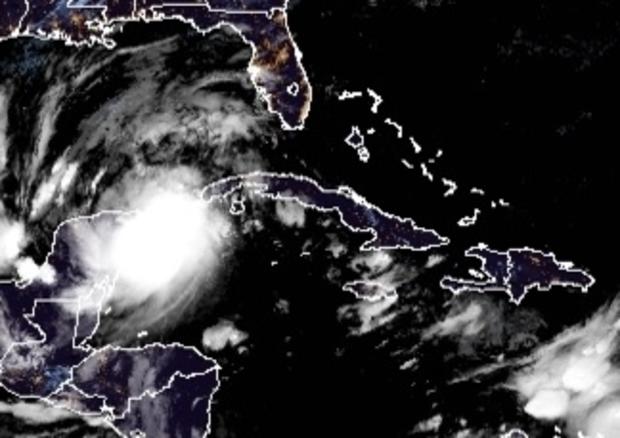Cancun, Mexico — A weakened but still dangerous Hurricane Delta made landfall Wednesday near Puerto Morelos along the northeastern coast of Mexico’s Yucatan Peninsula, bringing with it a possible “life-threatening” storm surge, the U.S. National Hurricane Center in Miami said. Puerto Morelos is just south of Cancun.
Satellite imagery, radar data from Cuba and surface observations in Mexico indicate that Delta’s center came ashore around 6:30 a.m. EDT as a Category 2 hurricane with sustained top winds of 110 mph.
Quintana Roo Gov. Carlos Joaquín said the state government had prepared, but warned residents and tourists that “it is a strong, powerful hurricane,” though he considered it a good sign that Delta had weakened a bit late Tuesday.
He said the area hadn’t seen a storm like it since Hurricane Wilma in 2005.
Delta’s winds increased in strength by 80 mph in just 24 hours, more than doubling from 60 mph at 2 p.m. EDT Monday to 140 mph at 2 p.m. Tuesday. Its top winds peaked at 145 mph before they diminished slightly as it closed in on Yucatan.
Delta’s rapid intensification was the fastest in the Caribbean since Wilma’s. That storm went from 75 mph to 185 mph in just 24 hours, notes CBS News meteorologist and climate specialist Jeff Berardelli.
Over the past few decades, intensification has been increasing by about 3 to 4 mph per decade due to hotter waters from human-caused climate change, he points out. That means a system in 1980 that may have intensified by 40 mph in 24 hours might now intensify at 55 mph in 24 hours.
CBS News meteorologist David Parkinson called Delta’s weakening from its 145 mph peak to 110 mph “a remarkable overnight turn of events” that could mean Yucatan is going to “dodge a major bullet.”
He said a Category 2 storm will still “bring about torrential rain, very damaging wind gusts and storm surge, so they won’t be unscathed. However, the difference in damage in those (wind speeds) is night and day.”
The hurricane center warned that Delta was still an extremely dangerous storm despite its weakening, with the potential to bring a “life-threatening” storm surge that could raise water levels 9 to 13 feet along with large and dangerous waves and flash flooding inland.
Delta was centered about 35miles east-northeast of Cozumel early Wednesday and moving west-northwest at 17 mph.
Delta was forecast to spend several hours lashing the Yucatan Peninsula before moving into the Gulf of Mexico and growing into a “considerably larger” storm before striking the U.S. Gulf coast. People in Louisiana or Mississippi should prepare now for hurricane-force winds to begin hitting their coastlines on Friday, the hurricane center advised.
Louisiana Gov. John Bel Edwards said Delta was expected to make landfall there Friday night or Saturday morning and the entire state is in the storm’s possible path. State and local officials in coastal areas were shoring up levees, sandbagging and taking other protections measures, he said.
Louisiana is still recovering from Hurricane Laura, which ravaged the southwestern region as it roared ashore as a Category 4 storm in August. More than 6,600 Laura evacuees remain in hotels around the state, mainly in New Orleans, because their homes are too heavily damaged to return.
Thousands of Quintana Roo residents and tourists waited for the storm hunkered down in dozens of government shelters. Everyone was ordered off the streets by 7 p.m.
Throughout Tuesday, the evacuations of low-lying areas, islands and the coastline widened as Delta exploded over warm Caribbean waters into a major hurricane. Much of Cancun’s hotel zone was cleared out as guests were bused to inland shelters. In Cancun alone, the government opened 160 shelters.
Some 300 guests and nearly 200 staff from the Fiesta Americana Condesa hotel were taken to the Technological Institute of Cancun campus. All wearing masks, they spread out on thin mattresses in a classroom building and tried to get comfortable as workers boarded the building’s windows in a light rain. Some played cards or watched videos on their phones, while others called relatives.
“The hotel has done a good job of making sure that we were provided for and that we’re going to be safe here in this place, so we don’t have any concerns at all,” said Shawn Sims, a tourist from Dallas sheltering with his wife, Rashonda Cooper, and their sons, 7-year-old Liam and 4-year-old Easton.
“This is my first (hurricane) experience, but I see that these guys have a plan and they know what they’re doing,” Sims said.
State tourism officials said more than 40,000 tourists were in Quintana Roo, a fraction of what would normally be there. Delta’s damage comes on top of months of pandemic-induced lockdown that has devastated the state’s tourism industry.
At the Cancun Convention Center, 400 tourists from hotels and rental properties bunked for the night.
“We hope that in this place we are surely much safer,” Quintana Roo Tourism Secretary Marisol Vanegas said. “This is a structure that has withstood other hurricanes.”
Mexico put the commander of its navy in charge of the federal response. President Andrés Manuel López Obrador said Tuesday that 5,000 federal troops and emergency personnel were being made available in Quintana Roo to aid in storm efforts.
Local and state officials urged residents to move to shelters.

